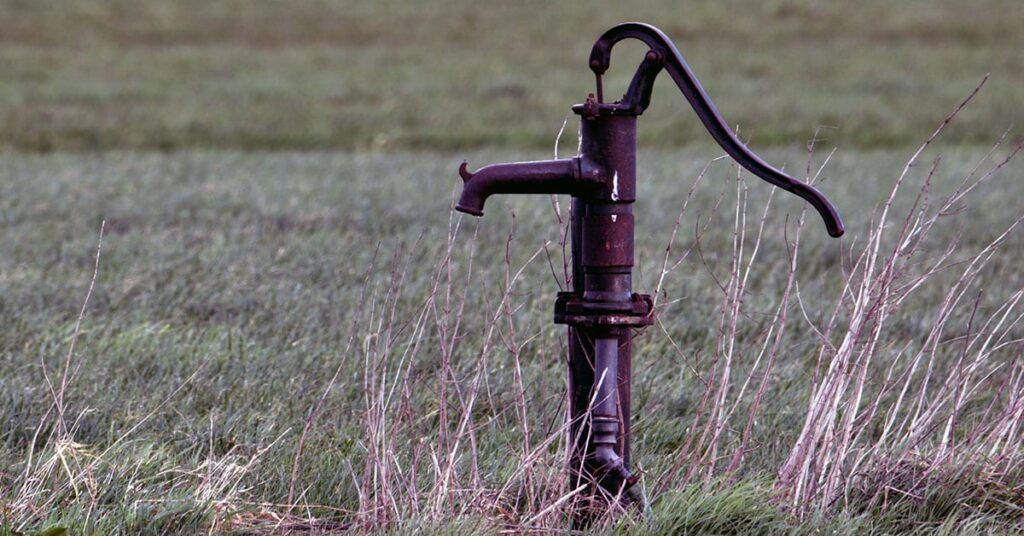Throughout the entire history of humanity, it’s been possible in many places around the world to locate water by simply digging a deep enough hole. Getting the water up out of that hole, though, there’s the problem. But it was a problem that began to be solved at least 4,000 years ago when the “shadoof” came into use in Ancient Egypt. A shadoof is a simple device that’s still in use; it’s a long pole with a bucket attached, supported by another vertical pole roughly in the middle. In the US (one place where it’s still in use) it’s called a “sweep”. Nobody knows for sure that the Egyptians were the first to use it; such a device — really the first pump — might be considerably older.
The word “pump” is also pretty old (for an English word, at least), and similarly, nobody knows for sure exactly where it came from. At least 1000 years ago there was a word in West Frisian: “pomp,” that had to do with moving water around. It might have been used to mean both a “pump” and a pipe or conduit. Middle Dutch had the word “pompe,” Middle Low German had “pumpe,” Old Swedish had “pump,” and so on. Regardless of the language, all of these words seemed to have meant generally the same things; devices for pumping water and/or the pipes (or culverts) that the water flowed in. As for where the word first arose, and who borrowed it from whom, nobody knows.
The English word “0ump” is pretty versatile. It’s both a noun (a device that raises water) and a verb (the act of raising water, usually by operating a pump). Along the way, “pump” has acquired a variety of figurative meanings as well. You can “pump” someone for information. The word has been used for a variety of bodily organs that performed a pump-like function (or at least somebody thought they did), from the heart to the lymph nodes to the tear glands: “Your pumps have been at work—you’ve been crying, girl” (1825). “Pump” is also used for devices that don’t really “pump” anything at all, but that are used in a way that reminds people of using a manual pump — a “pump-action shotgun,” for example.
Ships have pumps, not least because they leak. In the early 1500s “pump” was used to mean the lowest part of the ship (the bilge) that had to be pumped out. Everything else besides water collected in the “pump” of a ship too, and it got pretty nasty down there. That sense was carried over to a figurative usage of “pump” to mean anything filthy or vile (or anything or anyone that you wanted to denigrate, insult, or describe hatefully). For example, in the 1555 book Fardle of Facions by Joannes Boemus: “The king [drove out the Jews]..and they (as the poompe of all skuruines, not knowing wher to become) laye cowring vnder hedges.”
In the 1800s, a “pump” was a foolish, talkative person; a windbag: “My dear Mr. Macassar you are a pump…Sublimely stupid!” (1846, from Jockey Club by Edward Stirling).
The usage of “pump” as a shoe dates to the mid-1500s. Like the word itself, nobody is quite sure how a kind of shoe came to be called by the same name as a device for raising water, There are three theories. The first is that around that time in German there was a kind of baggy pants called “pumphose.” The idea is that maybe the kind of shoes you’d usually wear with those pants came to be called “pumps.” There isn’t much evidence for this theory — but then there isn’t much for the other theories either. The second theory has to do with a particular kind of mechanical pump — the kind you probably think of as a “pump” — it has a handle that you move up and down, and a spout for water. That kind of pump has an internal piston that makes it work. The piston has to fit pretty tightly — just like, this story goes, your foot has to fit pretty tightly in a “pump” style shoe, because pumps don’t have any laces or other fasteners; they just stay on your feet because they’re the right size.
The third origin theory for “pumps” as shoes also has to do with the lack of fasteners, but instead of referring to a tight fit, refers to the shoes being loose. When you walk in pumps that are a bit too big, they probably make a flapping sound with every step. That flapping sound, according to this theory, reminded people of the sound of a water pump, and that’s where the name of the shoe came from.
All three of these theories seem to be equally dubious. A much better one, which isn’t hard to find repeated, is that as soon as automobiles began to become popular, fuel stations began to appear. These stations needed attendants to fill the cars’ gas tanks. Gasoline is ridiculously flammable, and in the early 20th century men tended to smoke but women didn’t. So in order not to burn the place down, gas stations hired female attendants. The pavement in gas stations, especially back then, got pretty oily because early cars leaked. Not being ships, they didn’t leak into the pump, which could be pumped out. Instead, they leaked oil onto the pavement, and it got slippery. The female attendants, consequently, wore special shoes made not to slip. This, of course, would be the best theory of all if not for quotations like this, from 1598 (a bit before the invention of the automobile): “…also dancing pumps or little shooes.”

